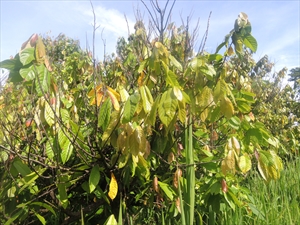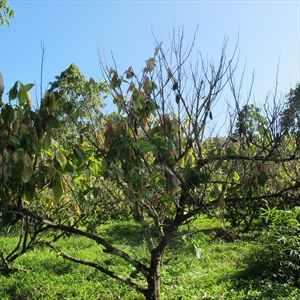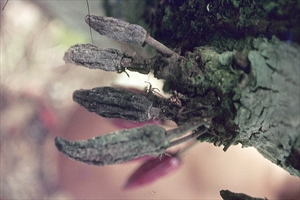Cocoa sunscald & cherelle wilt. 'Cherelles' are young pods that wilt during the first 6-8 weeks after pollination, when less than 10 cm long.
Pacific Pests, Pathogens and Weeds - Online edition
Pacific Pests, Pathogens & Weeds
Cocoa sunscald & cherelle wilt (137)
There are no scientific name for these physiological conditions: i) reaction of trees to lack of shade, and sun damage, and ii) early death of cherelles by a natural fruit-thinning process.
Both these conditions occur wherever cocoa is grown.
Cocoa
Sunscald: The first sign is leaf fall at the tips of branches; this exposes the young stems and they dieback. It happens especially on the vertical branches at the top of the trees. As the tips die, buds lower down develop into new shoots.
Cherelle wilt: At first, cherelles are red or green (depending on the variety); however, when they reach about 6-8 cm many of them stop growing, lose their colour, become infected by fungi and other decay-causing organisms, shrivel, rot and turn black, but do not fall. Note, sunscald can cause cherelle wilt, and so can the water mould, Phytophthora palmivora (see Fact Sheet no. 06), but the numbers are usually small compared to natural wilt.
Sunscald
This is a 'physiological' problem. Sunscald is not a disease; there is no pathogen. It occurs when cocoa trees are grown without shade, or the shade is removed when the trees are mature, and they cannot obtain enough nutrients from the soil. When the shade is removed and nutrition is poor, the tips of the branches die and the leaves turn yellow (Photos 1&2). This is called 'dieback. Cocoa trees need a soil rich in nitrogen, potassium and trace elements. It is not clear what effect sunscald has on yield: it will depend on its severity.
Cherelle wilt
This is also a 'physiological' condition. Flowers form, they are pollinated by midges, and cherelles - the young pods - develop (Photo 3), but many die (Photo 4). Cherelle wilt is a natural event. It is a fruit-thinning process, probably controlled by plant growth hormones. Generally, it does not affect yield. The cocoa tree allows as many cherelles to develop into mature pods as there are nutrients to support them. The same happens with many fruit trees; for instance, apples have a fruit drop (called the 'June drop' in Europe). However, cherelles of cocoa do not fall from the tree; they just rot.
Look for the upright branches on the tree without leaves, and unusual branching of the shoots. Look for cherelles that are black and often have a white fungal growth on them. In most cases, this fungus is not the cause of their death; it comes after the cherelles start to wilt. (It is different from Phyophthora palmivora, the cause of black pod disease. In that case, the water mould causes a brown rot with white growth on green (or red) cherelles and pods).
CULTURAL CONTROL
Sunscald
Cocoa is a shade-tolerant tree that likes moist, nutrient-rich, well-drained, deep soils; it does best under shade, unless farmers maintain yields by adding the appropriate nutrients. However, there are several reasons for keeping shade trees. Shade trees do the following:
- Return organic matter to the soil through falling leaf litter and decaying branches.
- Add considerable amounts of nitrogen to the soil (if legumes) due to their interaction with Rhizobium bacteria.
- Help to keep the soil moist in dry seasons.
- Slow soil erosion, and especially leaching of soil nutrients; this helps to sustain yields, as well as saving the need to clear more rainforest.
- Reduce growth of weeds.
- Provide an environment for greater biodiversity, as well as maintaining wildlife habitats, especially if under natural shade trees, rather than planted.
- Extend the productivity of old-growth cacao trees.
Cherelle wilt
Cherelle wilt can be reduced by improving the health of cocoa trees. The most important ways of doing this are:
- Fertilizers and mulches. In general, the greater the availability of nutrients the fewer cherelles that wilt.
- Light regime. The correct balance is needed between sunlight for the manufacture of plant foods, and sunscald that damages foliage.
- Tree density. Do not plant trees too close together. Cherelle wilt will increase if trees are too crowded because of competition for essential nutrients, water and light.
- Soil moisture. Keep soils moist, either with drains or mulches, as cherelle wilt is greater in soils that are either too dry or too wet.
- Control fungi and insects. This is probably only of secondary importance, unless there is an epidemic of e.g., black pod disease.
AUTHOR Grahame Jackson
Information from (including Photos 3&4) Gerlach WWP (1988) Plant diseases of Western Samoa. Samoan German Crop Protection Project, Deutsche Gesellschaft für Technische Zusammenarbeit (GTZ) Gmbh, Germany. Photo 1 Pita Tikai, ACIAR ICM/IPM project, Solomon Islands.
Produced with support from the Australian Centre for International Agricultural Research under project PC/2010/090: Strengthening integrated crop management research in the Pacific Islands in support of sustainable intensification of high-value crop production, implemented by the University of Queensland and the Secretariat of the Pacific Community.







